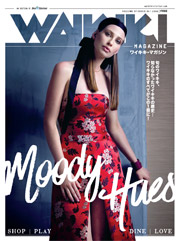The Waikiki Insider
Visitor Tips from Someone in the Know!
As a native Hawaiian who has lived, worked and played in Waikiki for much of my life, I have come to appreciate its many facets. In this column, I’m thrilled to be sharing my favorite Waikiki tips.
Waikiki
At night when the shadows are falling
I hear your rolling surf calling
Calling and calling to me
Waikiki
My whole life is empty without you
I miss that magic about you
Magic beside the sea
Magic of Waikiki
(From Waikiki by Andy Cummings)
The name alone evokes sandy beaches glistening in the sun against the backdrop of iconic Diamond Head, where beautiful hula dancers gracefully tell their stories and palm trees gently sway beneath a romantic moonlit sky. These are all a part of the Waikiki that I will always love … but Waikiki’s history is perhaps its biggest allure for me.
There have been numerous stewards of Waikiki’s history, but perhaps none like the late Dr. George Kanahele, whose vision to create the Waikiki Historic Trail www.waikikihistorictrail.com allows for kama‘aina (local residents) and mali-hini (newcomers) alike to trace legendary steps and imagine what once was.
Waikiki—once the seat of power for O‘ahu—was also the home and playground of our ali‘i, or ruling chiefs. My favorite Hawaiian song composed by Queen Lili‘uokalani was about her home, Paoakalani, located where the Waikiki Beach Marriott Resort & Spa now stands (Marker 3 on the trail). ‘Ainahau, where the Sheraton Princess Ka‘iulani Hotel is now located, was home to its beautiful namesake princess whose death at age 23 broke the hearts of the Hawaiian people (Marker 8). And King William Lunalilo, the first elected king in Hawai‘i, once had his summer home where the large banyan tree grows at the center of the International Market Place (Marker 9).
Hawaiian culture also has become a major feature of Waikiki’s visitor industry, which makes my heart sing! I recall working for a major hotel in the 1980s and fighting to include Hawaiian diacritical marks in Hawaiian words, as well as to offer Hawaiian cultural training for employees. We are most gracious in sharing that our living (and thriving!) culture is what makes us different from other “sun, surf and sand” destinations. Now, I am thrilled to see most hotels and shopping centers in Waikiki offering programs to celebrate Hawai‘i’s culture and unique history.
For example, Royal Hawaiian Center presents complimentary lessons in Hawaiian quilting, lomilomi, ukulele, hula, lei-making and kapa making. It also screens complimentary films on the heritage and history of Helumoa, the land on which the center sits, and the vibrancy of the Native Hawaiian People at the Kaulani Heritage Room. www.royalhawaiiancenter.com.
Outrigger Waikiki on the Beach offers various cultural programs for its guests, including opportunities to “talk story” with Hawaiian kupuna (elders), ukulele lessons, sampling of multi-ethnic foods, island art and music experiences, and Hawaiian crafts. Also, more than 4,000 couples have participated in its Hawaiian Vow Renewal Ceremony, a twice-weekly event on the beach, offered free to guests. www.outrigger.com.
Check with your concierge or guest services desk to see what cultural programs they offer—and sign up!
I look forward to sharing more with you, here, upon your next visit to Waikiki.










